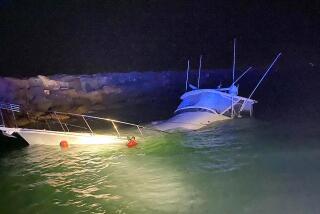Week in Review : MAJOR EVENTS, IMAGES AND PEOPLE IN ORANGE COUNTY NEWS : COURTS : Driver in Boat Crash Guilty of Manslaughter, but Jury Asks Judge for Leniency
- Share via
Two years ago five passengers were killed and three injured when Virl Earles crashed a boat into a concrete buoy in Seal Beach’s Anaheim Bay.
After one trial that ended in a hung jury, Earles was convicted of involuntary manslaughter by an Orange County Superior Court jury. But in a rare courtroom scene, the jury foreman rose and asked the judge, on behalf of the jury, for leniency.
“There has been enough suffering in this tragedy; no one gains by making this young man endure anything more,” jury foreman Cyrus Allen of Costa Mesa said later.
Judge Jean Rheinheimer allowed Earles, 30, of Seal Beach to remain free on his own recognizance until sentencing Oct. 10. The prosecutor and defense attorney agreed that the jury’s request for leniency may affect the sentence.
The five killed were Anthony Sutton, 27, Ronald Myers, 22, and John Bakos, 22, all of Seal Beach; Kathy Weaver, 24, of Laguna Beach, and Patricia Hulings, 20, of Downey. Passengers injured were Ernest Chavez, Carol Kemble and Stephen Brennan, all 26. The three survivors testified they did not consider Earles’ driving of the boat to be reckless.
The conviction of Earles on all five manslaughter counts on which he was charged was a shock to his family and friends. Earles appeared stunned to hear the verdict and cried continuously as he listened to the court clerk read the verdict.
Deputy Dist. Atty. John Conley said he did not know what kind of sentence he would recommend to Rheinheimer, but added, “If the jurors think leniency is called for, I don’t think we can ignore that.”
Gary Pohlson, Earles’ attorney, said he has “never seen a better candidate for probation.”
Earles and eight others left Peter’s Landing in Huntington Harbour about 2 a.m. Oct. 28, 1984, in a borrowed 20-foot power boat for a cruise to see the Queen Mary in Long Beach.
On the return trip, Earles drove the boat into the 11-foot-wide Navy mooring buoy at a speed of at least 25 m.p.h.
Earles contended that when he re-entered the bay, a missing light at the end of the west jetty guarding the entrance of the bay threw him off course. He thought he was in the middle of the safe boating channel, he said, when, in fact, he was several hundred yards off course.
After the first trial, Conley talked at length with some of the jurors, and discovered they had some mistaken impressions about the conditions of the harbor the night of the boat crash. Conley used a few additional witnesses familiar with the bay’s conditions, and a new aerial photograph of the bay, to show that Earles should have been aware of the danger of the buoy.
More to Read
Sign up for Essential California
The most important California stories and recommendations in your inbox every morning.
You may occasionally receive promotional content from the Los Angeles Times.












